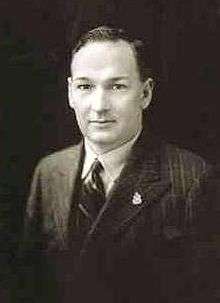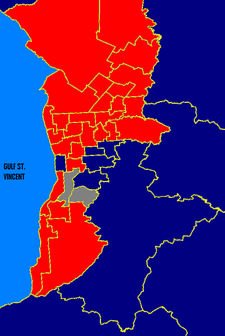Liberal and Country League
Liberal and Country League | |
|---|---|
| Historic leaders |
Richard Butler (1932–38), Thomas Playford (1938–66), Steele Hall (1966–72), Bruce Eastick (1972–74) |
| Founded | 1932 |
| Dissolved | 1974 |
| Preceded by |
Liberal Federation, Country Party (SA) |
| Succeeded by | Liberal Party of Australia (SA) |
The Liberal and Country League (LCL) was the major conservative party in South Australia from 1932 to 1974.[1] In its 42-year existence, it spent 34 years in government, mainly due to an electoral malapportionment scheme known as the Playmander, introduced by the LCL government in 1936, which saw a change from multi-member to single-member seats in the lower house, a reduction of seats from 46 to 39, and two thirds of seats to be located in rural areas ("the country"). This arrangement was retained even as Adelaide, the state capital, grew to two-thirds of the state's population. The most populous Adelaide-area seats had as much as 5-10 times the number of voters than the least populous rural seats − at the 1968 election the rural seat of Frome had 4,500 formal votes, while the metropolitan seat of Enfield had 42,000 formal votes. Additionally, with a decisive advantage to the LCL, swing voters may have been more likely to vote for the expected status quo LCL government.
It was succeeded by the South Australian Division of the Liberal Party of Australia in 1974.
History

Created on 9 June 1932 as the result of a merger between the Liberal Federation and the Country Party, the first of many LCL governments was formed, following the 1933 election under Richard Layton Butler. Traditionally a socially conservative party, the LCL contained three relatively distinct factions whose ideologies often conflicted:
- Farmers, graziers and rural property owners.
- The Adelaide Establishment of old money families and those fortunate enough, through marriage, to have been accepted by the Establishment.
- The urban middle class, who continued to support the party although they had little say in its running. Indeed, it was not until the election of Robin Millhouse in 1955 that someone from this third faction was elected to parliament. Millhouse, often considered during his term as the most progressive member of the LCL, was eventually expelled in 1973 for his continued criticism of the conservative wing of the party, going on to form the splinter Liberal Movement party with state and federal success.
Parliamentary leaders
- Richard Layton Butler (1932–1938) who served as Premier of South Australia until shortly after the 1938 election.
- Sir Thomas Playford (1938–1966) who served as Premier from 5 November until his electoral defeat at the 1965 election nearly 27 years later.
- Steele Hall (1966–1972) who succeeded Playford as leader of the LCL following Playford's 1966 resignation as party leader, served as Premier from 1968 to 1970.
- Bruce Eastick (1972–1974) who succeeded Hall as leader of the LCL following Hall's 1972 resignation as party leader.
It was Playford that the LCL would become synonymous with over his 26 years and 125 days as Premier (a world record for an elected national or regional leader).
LCL in power

The LCL became so strongly identified with Playford that during election campaigns, voters were asked to vote for "The Playford Liberal and Country League". Playford gave the impression that the LCL membership were there solely to raise money and run election campaigns; his grip on the party was such that he frequently ignored LCL convention decisions. This treatment of rank and file party members continued to cause resentment throughout the party, the first public inkling of which was the reformation of a separate Country Party in 1963. Although a shadow of its former self, the reformed Country Party served as a wakeup call to Playford that there were problems within the LCL.
This split mirrored the dissatisfaction amongst the Establishment faction, which had been steadily losing its power within the party and was appalled at the "nouveau riche (new money) commoners", such as Millhouse, that had infiltrated the parliamentary wing of the LCL. Added to this mix was the important factor that the LCL party machine had become moribund as leaders had become lulled into a false sense of security due to the extended run of election wins aided by the Playmander. The LCL was thus caught unawares in the early 1960s, when Labor eschewed a statewide campaign in favour of targeting marginal LCL seats.
Due to these factors, the LCL's grip on power began to slip in the 1950s; they would lose seats in every election from 1953 onward. Even at the height of Playford's popularity, the LCL was almost nonexistent in Adelaide, winning almost no seats in the capital outside the wealthy "eastern crescent" and the area around Glenelg and Holdfast Bay. Due to its paper-thin base in the capital, the LCL never held more than 23 seats at any time during Playford's tenure.
After retaining government with just 46.7 percent and 47 percent of the two-party vote at the 1944 election and 1953 election, the party's record-setting run in government was almost ended at the 1962 election with just 45.7 percent of the two-party vote but again retained government. Under Frank Walsh, Labor won a decisive 54.3 percent of the two-party preferred vote, normally enough for a comprehensive victory. However, due to the Playmander, Labor only picked up a two-seat swing, leaving it one short of a majority. The two independents threw their support to the LCL, allowing Playford to remain in office.
LCL fall from power
The LCL lost government for the first time at the 1965 election. Despite winning the same two-party vote as it had three years earlier, the Playmander was strong enough that Labor was only able to win government by two seats. Playford resigned as party leader in 1966 and was succeeded by Steele Hall.
At the 1968 election, Labor won a 53.2 percent two-party vote, but suffered a two-seat swing, resulting in a hung parliament. The lone independent in the chamber, Tom Stott, threw his support to the LCL, allowing it to regain government under Hall. Hall was embarrassed that his party was in a position to win power despite having clearly lost the vote. Concerned by the level of publicity and public protest about the issue, Hall reduced the rural weighting and expanded the lower house from 39 to 47 seats, 28 of which were located in Adelaide. The reforms fell short of "one vote one value", as Labor had demanded, since rural areas were still overrepresented. Nonetheless, conventional wisdom was that Hall was effectively handing the premiership to Labor leader Don Dunstan at the 1970 election. At that election, again with little change in the vote but a very different set of seats, Labor won a convincing majority and took government. Hall remained Leader of the Opposition for two years before resigning from the LCL, claiming that the Party had 'lost its idealism [and] forgotten...its purpose for existence'. Bruce Eastick took the LCL leadership.
However, it was Playford's resignation as LCL Leader that acted as the spark for the party's problems to emerge in public spats, culminating in the formation of the Liberal Movement. The Liberal Movement was a socially progressive wing of the LCL that subsequently split from the party.[2] Following the split, the LCL under Eastick changed its official name to "Liberal Party of Australia (South Australian Division)" in 1974 to bring it into line with the federal Liberal Party of Australia. The LCL ended its existence in acrimony and in opposition, but having spent 34 of its 42 years in power.
One vote one value would be introduced by Labor following the 1975 election where the newly formed Liberal Party won a 50.8 percent two-party vote but fell one seat short of forming government. Labor would regain their vote and majority at the 1977 election, however Dunstan resigned in the months prior to the 1979 election where the Liberals won government for one term.
The last surviving parliamentarian from the LCL, Graham Gunn, retired in 2010; he had been elected in 1970, the next-to-last election that the party fought under the LCL banner.
Results 1933–73
The LCL began in 1932 and ended in 1974. The Playmander began in 1936 and ended after 1968. Two-party-preferred (2PP) figures are not available prior to 1944.

| Results 1933–1973 | |||||||||
|---|---|---|---|---|---|---|---|---|---|
| % (seats) | ALP | LCL | IND | OTH | ALP 2PP | LCL 2PP | |||
| 1973 | 51.52 (26) | 39.79 (20) | 4.32 | 4.37 (1) | 54.5 | 45.5 | |||
| 1970 | 51.64 (27) | 43.76 (20) | 1.46 | 3.14 | 53.3 | 46.7 | |||
| 1968 | 51.98 (19) | 43.82 (19) | 1.03 (1) | 3.18 | 53.2 | 46.8 | |||
| 1965 | 55.04 (21) | 35.93 (17) | 1.88 (1) | 7.16 | 54.3 | 45.7 | |||
| 1962 | 53.98 (19) | 34.51 (18) | 3.15 (2) | 8.37 | 54.3 | 45.7 | |||
| 1959 | 49.35 (17) | 36.95 (20) | 5.93 (2) | 7.77 | 49.7 | 50.3 | |||
| 1956 | 47.37 (15) | 36.69 (21) | 7.34 (3) | 8.60 | 48.7 | 51.3 | |||
| 1953 | 50.84 (14) | 36.45 (21) | 11.10 (4) | 1.60 | 53.0 | 47.0 | |||
| 1950 | 48.09 (12) | 40.51 (23) | 10.07 (4) | 1.34 | 48.7 | 51.3 | |||
| 1947 | 48.64 (13) | 40.38 (23) | 6.20 (3) | 4.77 | 48.0 | 52.0 | |||
| 1944 | 42.52 (16) | 45.84 (20) | 6.64 (3) | 5.00 | 53.3 | 46.7 | |||
| 1941 | 33.25 (11) | 37.55 (20) | 29.20 (8) | 0.00 | |||||
| 1938 | 26.16 (9) | 33.44 (15) | 39.73 (14) | 0.66 (1) | |||||
| 1933 | 27.78 (6) | 34.62 (29) | 13.41 (3) | 24.19 (8) | |||||
| Primary source: WA Uni – TPP sources: ABC and Professional Historians | |||||||||
| Wikimedia Commons has media related to Liberal and Country League. |
References
- ↑ Liberal Party of Australia, South Australian Division: SLSA.sa.gov.au
- ↑ "The 1970s". SA Memory:Past, Present for the Future. 16 May 2007. Archived from the original on November 12, 2009. Retrieved 28 May 2015.